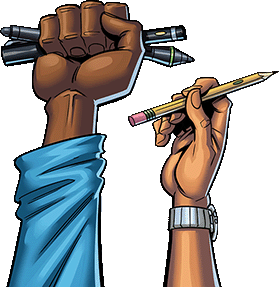Comic Printing: Five Ways to Help Your Comic Stand Out
March 9, 2021
The journey from a simple idea in your head to holding a copy of your comic book in hand is a long one and requires hard work. There are quite a few comic book creators in the comics industry, all of them pumping out content that competes with your creative endeavor.
Certain details may help your graphic novel or comic book stand out from the crowd. With visual and literary hooks, bold use of color, and attention to speech bubble placement, your comic book will leap out at potential readers and have them flipping through the pages in no time.
1. Make Them Turn the Page
You want to leave your readers wanting more. Creating a hook (or cliffhanger) is a literary device used by many writers, from Dickens to Mark Twain. You want to create a hook, so your readers are dying to turn the page and find out what happens next.
It’s not easy to create a cliffhanger, but the more you’re aware of the natural breaks in your plot’s action, the more opportunities you’ll see for the placement of an excellent hook.
Usually, a hook consists of a surprise, reveal, or a line from a character with a lot of importance. Although hooks are helpful, make sure they feel natural. A forced hook won’t have your readers clamoring for more; in fact, it might make them put down your comic book.
A comic book is like a short story that’s told using visual images and color. Look at the plot of your comic book as a whole to note where the best places for a natural hook are.
2. Use Color to Change Scenes
Sometimes it’s challenging to transition from scene to scene. Readers can become confused if you take them out of one setting and set them in another too quickly, and a confused reader is not fully engaged in your comic book plot.
Color is a subtle and straightforward way to indicate changes in your comic. This could mean changes in setting or changes in a character’s perspective. For example, if one scene involves characters trapped in a cave and then the scene quickly changes to the rescuers approaching the cave’s mouth, you have to signal that a sudden scene shift is about to occur.
Using color washes (like blue for inside the cave and red for outside) or color themes for specific scenes or characters will tell your readers something’s changing without having to say it outright.
3. Be Careful With Your Speech Bubbles
Many comic book artists forget about speech bubbles when crafting the storyboard to their comic book idea. When you write your script and then transfer those story ideas and plot points to images, you should make room for word balloons and sound effects.
A rookie mistake is to pack your panels with tons of images, but when it’s time to add speech bubbles, you realize you don’t have enough room on your page layout for all the elements you’ve included.
In any draft, a black-and-white sketch or a detailed storyboard, keep all the elements in the comic book page layout, including any bubbles that contain text. When you finally see your printed comic, it won’t look crowded or overdone.
4. Identify High Points
As a writer, you have particular strengths that help you stand out from the crowd. Some writers excel at snappy dialogue, whereas others love to write action scenes. Either through peer review or by sharp self-awareness, identify what you do best as a writer and highlight that in your comic book.
If you are a writer who excels in action scenes, extend and amplify any scenes that involve a lot of action. If dramatic emotional scenes are your strong suit, make sure any scenes in your comic book that have emotional chords are front and center.
5. Build a Storyboard
The perfect transitional process between writing a story and drawing a comic is a storyboard. This tool guides you through the creation process in a way that nothing else can.
A storyboard contains both the written and drawn elements of your comic in one place. The drawings in your storyboard don’t have to be perfect; they just have to represent your characters and the other elements in the graphic novel coherently.
Some writers and artists find that drawing the outline of a page and then adding in all the panels with speech bubbles and descriptions, if necessary, can help them see their comic book more objectively.
It’s a bright idea to note, on your storyboard, how big each cell is and what kind of perspective it has. Noting the size and shot – zoomed-in, long, wide, or medium – of all the visual elements in your comic book will help you maintain tight control over it throughout the publication.
Storyboards are a great learning tool as well. If you work collaboratively with other artists or like to share your creative process, including a storyboard of an original comic book can be an exciting extra for your readers.

The Last Word
Visual storytelling is an art that humans have practiced since they picked up brushes and painted images on cave walls. To write a comic book that will stand out from the rest, you should think about how to create hooks, highlight your strengths as a writer, and create subtle tonal and mood shifts using color.
With a team of professional printers like those at Comix Well Spring, you can lean into their expertise as you hammer out the creative details within your plot. When you finally hold your finished product, whether saddle-stitched or perfect bound, you will feel a rush of accomplishment like no other. Contact Comix Well Spring today to start your creative journey with an experienced team of professionals.


